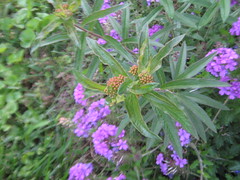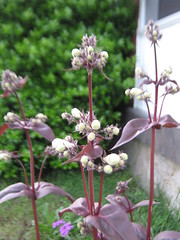My initial attraction to native plant gardening was the lack of continued work needed. In theory you plant something according to its needs and you're done. Almost all native plants are perennials so they only get stronger. After that I liked the idea of using local products, local retailers for those products and I liked having plants that were different than what you buy at your regular garden store. A lesser point of interest was that by planting the right mix of items you will build a naturalistic, native habitat in your yard. But what does that mean? It means animals! You add sun-loving wildflowers to get bees, butterflies, moths and hummingbirds. You add shrubby plants to provide shelter for small birds, mammals & reptiles. You add water elements (rain garden) with appropriate plants because everything needs water. You add fruit bearing shrubs and trees so the animals have something to harvest in the colder seasons.
Granted, gardening brings its own beauty with the flowers and foliage and shaded areas and benefits but to think that you are giving sustenance and shelter to creatures who used to have an abundance, right where you live, is an amazing concept and a wonderful benefit of good natural landscaping. Its also a teaching tool; as a new parent I can see that having this type garden I can show Julia the cycle of life and death, the efficiency of nature, and the harmony within nature. Shoot, I can even teach her colors, shapes, numbers and Latin...pretty much the only Latin I know is related to the plants I've been buying.
I have been intrigued and excited about this habitat stuff recently b/c I have seen some cardinals in abundance (or maybe I am seeing the same two over and over) in my yard. There is something between my house and backyard that they seem to love, I see them perched or flying through the same spot every day. I don't remember seeing them this often in years past. Of course, there are rabbits and snakes and squirrels (who have been planting black walnuts all over my yard) too, who are all showing up with minimal help from me.
 My goal is to bring more animals by way of proper habitat building gardening. My front yard gets sun all day which means its great for bee attracting plants and flowers. I started with a little square where I planted rose verbenas, penstemon digitalis and butterfly weed (2 each) last summer. This year they have all exploded. The verbenas have spread more than I imagined, the penstemons are taller than I imagined and the butterfly weeds are bolder in
My goal is to bring more animals by way of proper habitat building gardening. My front yard gets sun all day which means its great for bee attracting plants and flowers. I started with a little square where I planted rose verbenas, penstemon digitalis and butterfly weed (2 each) last summer. This year they have all exploded. The verbenas have spread more than I imagined, the penstemons are taller than I imagined and the butterfly weeds are bolder in  color than I remembered. My goal is to have those flowers repeating throughout my wildflower garden with the addition of some herbs, other wildflowers, shrubs and grasses mixed in. I don't know how I am actually going to put it all together but the ideas are coming. I also anticipate adding some more trees and a rain garden. I don't want it to be too overgrown with plants but I want to replace as a lot of the sod.
color than I remembered. My goal is to have those flowers repeating throughout my wildflower garden with the addition of some herbs, other wildflowers, shrubs and grasses mixed in. I don't know how I am actually going to put it all together but the ideas are coming. I also anticipate adding some more trees and a rain garden. I don't want it to be too overgrown with plants but I want to replace as a lot of the sod.The west side is almost all shade and would be a great starting point for the rain garden. There is a strip near the garage that someone suggested as an edible garden (blueberries, serviceberries, etc). The back yard is for Johnders and will remain the same (grass, natural groundcover like wild ginger and common strawberry) but I also will let trees that sprout grow as 2 or 3 already have. Lastly, there is the fence line, a space about 15' wide that runs then entire north/south length of the yard. The grassy portion has underground cables so I have to be careful what I plant. This is not my property even though I, like my Dad before me, keep it mowed. If I can plant the right things I can block the view of my neighbors unhappy yard and house as well as eliminate the need to mow.
As all gardens it is a work in progress but I am excited about the potential.

